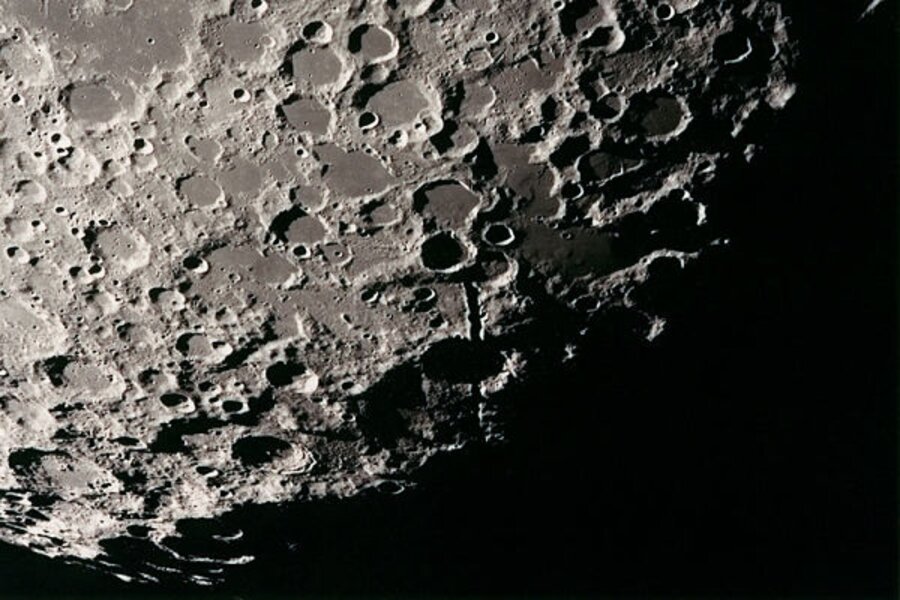Life's foothold on Earth may reach back 4.4 billion years
Loading...
Let's face it: Microbes make the contestants on CBS's "Survivor" look like pansies.
Scientists continue to marvel at the harsh conditions microbes can thrive in – and the tiny critters don't have a conniving protein in their cells.
But surely these denizens couldn't have survived the smack-around a young Earth and moon endured some 4 billion years ago. For roughly 100 million years, asteroids from the main asteroid belt between Jupiter and Mars pummeled the pair (as well as Mercury, Venus, and Mars).
Along come Oleg Abramov and Stephen Mojzsis to say, yep, it's very likely microbes survived. If that's the case, the origins of life on Earth could reach as far back as 4.4 billion years ago – far earlier than previously thought. And its trajectory through today was uninterrupted.
"Our results strongly suggest that no events since the moon's formation were capable of destroying Earth's crust and wiping out any biosphere that was present," offers Dr. Mojzsis, an assistant professor of geological science at the University of Colorado at Boulder. "Instead of chopping down the tree of life, our view is that the bombardment pruned it."
The implications reach much farther than the third rock from the sun, according to Lynn Rothschild, an evolutionary biologist working at the National Aeronautics and Space Administration'ss Ames Research Center at Moffett Field, Calif.
In a commentary that accompanies the formal report of the results in today's issue of the journal Nature, she points out that the results bode well for the emergence of life in other solar systems where potentially habitable planets have taken as rough a beating as Earth has.
So what did Mojzsis and Dr. Abramov, a post-doc at the university, do?
Essentially, they tried to figure out if the pummeling, known as the Late Heavy Bombardment, made habitats too hot for microbes to handle.
Other researchers held that the collisions would have heated the land and oceans to temperatures high enough to sterilize habitats, at least temporarily. And the collisions would have come fast and furious, in geological terms, preventing life from reestablishing itself between thumps.
That meant that life either got a very early start, got snuffed out, and had to start over – or it didn't emerge at all until after the monstro bombardment. The latter possibility has led to speculation that microbes from, say, Mars, hitched rides to Earth on collisions debris – alias meteoroids – and played a key role in seeding Earth with organisms once the collisions waned.
Mojzsis and Abramov based their calculations on the latest crater records for Mars, Earth, the moon, Venus, and Mercury. These yield an estimate of the asteroids' range of sizes and relative numbers for each size. They enlisted the help of the latest solar-system formation models, which trace the movement of solar system objects over time in ways that yield collision rates matching the crater records. Finally, they used detailed calculations of how Earth's crust and mantle would have heated in response to the size of the colliders and frequency of collisions.
The bottom line: To be sure, the surface in and around an impact site would have become no-microbe zones. But microbes also thrive thousands of feet underground. These habitats – especially outside of an impact zone – would have remained untouched.
In some cases, a collision might have actually increased available living space by introducing new cracks in the crust through which water could seep.
If microbes found moderate heat to their liking, they were toast. But any so-called thermophiles, which can thrive in high heat, would have been quite happy, thank you very much. And if modern oceanography has shown us nothing else, it's that where new crust is forming – where it's really hot – thermophiles are happy campers.
At worst, the duo calculates, only 37 percent of Earth's crust was sterilized. At no time during the bombardment did the planet get hot enough to vaporize the oceans.
If they are correct, their work could help explain why scientists have traced the last common ancestor of all living organisms today to an unknown type of thermophile microbe – one that emerged after the collision between the Earth and a Mars-sized object (the one that many scientists think formed the moon) and survived the Late Heavy Bombardment. [Editor's note: This paragraph was edited for clarity after initial publication.]





